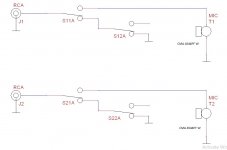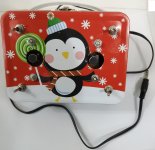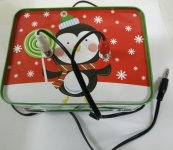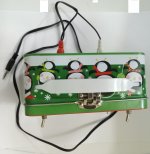PC's' sound cards usually have two independent stereo channels for microphones with phantom power on each of them, convenient for electret condenser microphones.
The word stereo, in this sense, describes the electronics. The two microphones may have similar signals, yet, each of them goes through a separate channel and is recorded by the PC and stored as a separate track.
In terms of the microphones, whether they are omnidirectional or not, when they are close to each other, the difference would be negligible, yet, there may be some :
* caused by a different volume level, when the sound source is closer to one of the microphones than the other
* caused by a phase difference ( different delay ) because of the same reason ( this is negligible )
* caused by a phase shift ( different delay ) because of the difference in the microphones and the channel parameters ( this is also negligible )
All of these may not be possible to be heard by a human.
However, in a case of a stereo microphone, the third cause, the difference because of the manufacturer's tolerances of microphones and channels, is even more negligible as this difference will not be present in the electronics but in the human head where the two channels are combined. Humans are not so good to be able to here any such of a difference. In the worst case, any difference will be worked out by the human brain as a 3D positioning and not as any distortion, nonlinearity, etcetera.
Some PC microphones have only one electret condenser microphone which they connect to each of the channels and some cannot cover the whole audio range of 20Hz to 20KHz. Some have lower sensitivity than others.
I have, therefore, made a stereo microphone with two electret condenser microphone where each of the microphones takes phantom power from and displays the signal to only one of the channels. I have used two CMA 4544PF W which are 20Hz to 20KHz, 3V to 10V microphones with good sensitivity.
When the PC is set up to 100% microphone level and 0% microphone boost, the signal is excellent when one talks 60cm away from the microphones and very good when one is 1m away.
Attached are simple schematics and more.
The word stereo, in this sense, describes the electronics. The two microphones may have similar signals, yet, each of them goes through a separate channel and is recorded by the PC and stored as a separate track.
In terms of the microphones, whether they are omnidirectional or not, when they are close to each other, the difference would be negligible, yet, there may be some :
* caused by a different volume level, when the sound source is closer to one of the microphones than the other
* caused by a phase difference ( different delay ) because of the same reason ( this is negligible )
* caused by a phase shift ( different delay ) because of the difference in the microphones and the channel parameters ( this is also negligible )
All of these may not be possible to be heard by a human.
However, in a case of a stereo microphone, the third cause, the difference because of the manufacturer's tolerances of microphones and channels, is even more negligible as this difference will not be present in the electronics but in the human head where the two channels are combined. Humans are not so good to be able to here any such of a difference. In the worst case, any difference will be worked out by the human brain as a 3D positioning and not as any distortion, nonlinearity, etcetera.
Some PC microphones have only one electret condenser microphone which they connect to each of the channels and some cannot cover the whole audio range of 20Hz to 20KHz. Some have lower sensitivity than others.
I have, therefore, made a stereo microphone with two electret condenser microphone where each of the microphones takes phantom power from and displays the signal to only one of the channels. I have used two CMA 4544PF W which are 20Hz to 20KHz, 3V to 10V microphones with good sensitivity.
When the PC is set up to 100% microphone level and 0% microphone boost, the signal is excellent when one talks 60cm away from the microphones and very good when one is 1m away.
Attached are simple schematics and more.
Attachments
I use school pencil boxes for projects due to the EMI rejection of a steel box. But I usually spray them with a $3 paint can before deploying. I've found the original clasp rather useless for more than one use, and glue velcro strips on them to keep them shut. 3M weatherstrip adhesive works better than the velcro included adhesive.
Interesting the sound card (I didn't buy) provides the phantom power to both channels. I bought a cheap used PA mixer to do the phantom power and level setting for 2 condensor mikes. Then a dual 1/4 phone plug to 1/8" stereo phone plug adapter cable from mixer main out to the PC internal line input. The mixer is much heavier than your mike, plus the weight of two mike stands. For home recording this is fine. Out and about, your solution looks handy.
Interesting the sound card (I didn't buy) provides the phantom power to both channels. I bought a cheap used PA mixer to do the phantom power and level setting for 2 condensor mikes. Then a dual 1/4 phone plug to 1/8" stereo phone plug adapter cable from mixer main out to the PC internal line input. The mixer is much heavier than your mike, plus the weight of two mike stands. For home recording this is fine. Out and about, your solution looks handy.
I use school pencil boxes for projects due to the EMI rejection of a steel box. But I usually spray them with a $3 paint can before deploying. I've found the original clasp rather useless for more than one use, and glue velcro strips on them to keep them shut. 3M weatherstrip adhesive works better than the velcro included adhesive.
Interesting the sound card (I didn't buy) provides the phantom power to both channels. I bought a cheap used PA mixer to do the phantom power and level setting for 2 condensor mikes. Then a dual 1/4 phone plug to 1/8" stereo phone plug adapter cable from mixer main out to the PC internal line input. The mixer is much heavier than your mike, plus the weight of two mike stands. For home recording this is fine. Out and about, your solution looks handy.
I decided to use an inexpensive tin can from the dollar shop just for difference. The tin can is very thin and can be strengthened with rubber or plastic tights to prevent vibration, although I do not thing such would have an effect. Of course, the best is to use a standard Aluminium enclosure. Of course, Copper is even better.
To have the microphones in separate enclosures is a better approach as one of them can record the voice and the other : a guitar, for example. I decided to put them in one container and to use them as one dual channel microphone. I can make another one the same and use one microphone of one of the dual channel microphones for one channel and one microphone from the other dual channel microphone for the other. I even purchased two enclosures but I did not make two dual channel microphones yet. I have two independent switches for this purpose too.
The Internet says there are two types of sound cards : single phantom power ( usually for a single microphone ), and dual phantom power. two channels. The one I have is two independent phantom powered channels.
I am to make more microphones with additional electronics which I would post when ready. The one I have made does not contain any electronics at all, just two microphone capsules.
Without electronics, there is still a possibility to make one microphone and connect this to the two PC card channels. However, the current through the microphone would double. However, because the current is very low, the PC card should not have a problem. For example, when the phantom power is 3V ( from power supply ) through 2.2K resistors, when the inputs are combined, there will be 3V through a 1.1K equivalent resistor. The microphone would consume a maximum of 0.5mA RMS which is not a problem for the card. The signal will not be DC centered the same but this is not important because the signal is very low, 50mV max ( says the Internet ), and the DC component is filtered by capacitor in sequence to the input inside the card. As far as microphone performance is concerned with 1.1K v 2.2K, I do not have any information but think would be OK.
Now, the problem is when there is one microphone connected only to one channel of a dual channel PC card. Then, this microphone will be displayed only to one of the stereo channels. Mixing with software is possible ( I have a ground connection for the one which is not used ) BUT most of the software does not allow this. A better approach would be to tell the software to use only one channel and put this into the two channels BUT most of the software would not have this option.
So, yes, the best way is to have two microphones in two separate enclosures. These can even be made to be attachable to and detachable from each other. I decided to make two dual channel microphones and select only one from each to make a detached microphone. The only advantage of this is the microphone is mechanically more convenient : one can move one container easily than two when one wants to use only one dual channel microphone, etcetera.
The advantage of two detached microphones is huge when one wants to record a song and record MAINLY the guitar into one channel and MAINLY the voice into another.
Also, I have decided to use standard IC sockets and plug the capsules in. This way I can remove and change any of the microphones. This is good to have because the expensive capsule microphones, such as Panasonic may become inexpensive. Important is the sound card voltage of typically 3V ( not sure but sources say so ) which must be supported by the microphones.
A document, called Errata.doc has been published here : Errata - Google Drive
The document correct errors I may have made in various projects I have worked on.
The document is to be updated.
Please, report all errors and problems.
The document correct errors I may have made in various projects I have worked on.
The document is to be updated.
Please, report all errors and problems.



